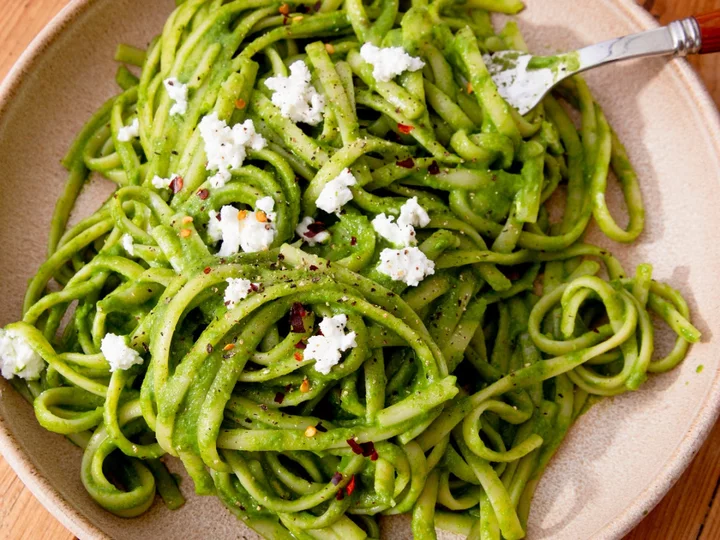
Do it for the Gram: Speedy but spectacular goat’s cheese linguine
This vibrantly green pasta recipe is one of my favourites in the book,” says Mimi Harrison, author of Beat The Budget. “Not only is it bright and Instagrammable, it’s also so delicious. The frozen spinach is reasonably priced and you don’t have to worry about it going off in the fridge. And the goat’s cheese provides creaminess, acidity and tang, all in one ingredient (hello, cost-effective!). “This is ideal for a speedy meal when you’re in a rush, or to serve to friends at a dinner party when you don’t want to spend half the night in the kitchen.” Goat’s cheese, spinach and basil linguine Serves: 5 Ingredients: 1 tbsp olive oil 1 onion, diced 500g linguine 3 garlic cloves, finely grated 160g frozen spinach 125g goat’s cheese 30g fresh basil Salt and pepper to taste Chilli flakes (optional) Method: 1. Set a non-stick pan over a medium heat and add the olive oil. Add the onion, season with salt and pepper and gently fry for four minutes. 2. Meanwhile, set a large pan of salted water over a medium heat and bring to a boil. Add the linguine and cook for two minutes less than the packet cooking time. 3. While the pasta is cooking and once the onions have softened, add the garlic to fry for a minute before adding the frozen spinach to the pan, along with 400 millilitres of the starchy pasta water. Increase the heat and cook the spinach and onion mix until the pasta is ready. 4. Add the spinach and onion mix to a blender with half of the goat’s cheese and the basil and blitz until smooth. 5. Drain the linguine and transfer back to the pan. Pour over the blended sauce and continue to cook over a low\medium heat. 6. After about two minutes, the sauce should thicken and coat the linguine. Serve with a sprinkle of any remaining goat’s cheese and a pinch of salt and pepper. Optionally, top with chilli flakes if you love a little heat. ‘Beat The Budget’ by Mimi Harrison (Ebury Press, £16.99). Read More The dish that defines me: Mallini Kannan’s baked honey-soy salmon Breakfast for dinner and four other things you should cook this week How to save money in the kitchen according to top chefs Money-saving chilli con carne that absolutely slaps with flavour How to pimp up your instant ramen (and save money) Where to find the best Guinness in London – and how to spot a bad one
2023-08-16 13:50

The dish that defines me: Mallini Kannan’s baked honey-soy salmon
Defining Dishes is a new Indyeats column that explores the significance of food at key moments in our lives. From recipes that have been passed down for generations, to flavours that hold a special place in our hearts, food shapes every part of our lives in ways we might not have ever imagined. I came up with this baked honey-soy salmon dish in the first flat I ever had all to myself, as a master’s student in Stirling, Scotland. I think that’s what makes me feel most proud of it, because it was the first thing I made that made me truly feel like an adult. I was 25 and had been living away from home in Malaysia for nearly five years, and although I never really cooked with fish, I was really craving it, particularly Chinese steamed fish. Salmon was relatively cheap in Scotland, but I always felt that there was something about cooking fish that was very intimidating. It felt like it was too fancy for me. I also feel like it’s still socially acceptable to eat overcooked, dry chicken breast, but eating overcooked fish is just much more unpleasant and no one wants that. But something came over me one day when I saw a fresh salmon fillet with a really good discount in the Tesco clearance aisle. Maybe that should tell you something about me – I don’t know if others would consider that safe – but it looked good and I said, “You know what, maybe today’s the day”. At the time, it so happened that honey-soy salmon was really trending, I had seen it all over the place. I didn’t Google a recipe, I just sort of figured out what flavours could be good on a piece of fish. I made a sauce using soy sauce, Chinese cooking wine and maple syrup (which was gifted to me by one of my very nice friends), poured it on top of the fish and shoved it in the oven, because I didn’t have a steamer then. I did look up how long to cook it for, and Google said 20 minutes. I ate it with steamed rice and to my delight, surprise and relief, it was absolutely delicious. I felt really good about it. It was a real level-up moment in my life. It was the first time I had made a difficult dish, even though the actual labour wasn’t difficult at all and it is essentially a very simple dish. It made me feel like I could do it; I could make grown-up food. At the time, I was 24 or 25-years-old and I had been living away from home for some time, but never without housemates. So I was truly on my own. It was a revelation to realise that I could make Chinese food like this at home. I come from a Malaysian-Indian family. We don’t steam much of anything and so if I wanted steamed fish, I’d have to go to a Chinese restaurant. But now, I didn’t really have to. After that, it became my hyper-fixation meal. I just couldn’t get enough of it and made it all the time – at the peak of my fixation, I ate it three times a week. But I did learn that it does not make for good leftovers. It must be eaten on the day it’s made, otherwise the fishy smell gets a bit unappealing. Once I learned that, I ate it about once a week, and each time I’d experiment with it. I learned the importance of adding aromatics like garlic, ginger, spring onions, coriander and chili. But the key motivator to my experiments was laziness. Could I get away with not slicing things up? What if I don’t want to turn the stove on? How can I cut corners? No matter what kind of nonsense I threw at it, it has always turned out reliably good. The first time I cooked the dish for someone else was when my parents came to visit me from Malaysia. We had just returned from a trip, and they were staying in my flat for a week and it was the first time they came to a place that was truly mine. I remember very clearly cooking the salmon for them because a couple of friends had invited me out to the pub that night and I wanted to go, but I didn’t want to order takeaway for my parents – they were at that stage in their holiday when all Asian parents get grumpy because they haven’t had rice in three days and it was paramount that they ate some immediately. I had 30 minutes before I had to get going to the pub, and I figured that I knew how to cook this dish so well by now that I could get it done in 20 minutes. However, it was also the first time I had scaled a fish. Before, I just cooked the fish with scales and all, I didn’t even realise you had to take them off. For some reason, this time I decided I needed to scale this slab of salmon. I read one Google-recommended article and was like: “Let’s go.” What they don’t tell you is that scales fly. They go absolutely everywhere. And there’s a kind of black coating, like a slime, on the fish that will also go everywhere. I remember my parents peeking their head around the kitchen door to ask if everything was OK, and me just barking: “YA IT’S FINE.” I had to get that thing in the oven NOW, so it had to happen. And you know what? It turned out great. This was the second dish I’ve made for my parents that they’ve said: “Oh, wow.” The first time was for a prawn curry, but this was special because they were so impressed by the efficiency of it and also, it was the first time they realised that wow, I’m an adult, I’ve figured it out. They were used to me making good food, but this was the first practical dish; it’s not me sitting in the kitchen, having to cut a mountain of onions and pounding galangal. Last year, after I moved to Virginia to be with my husband, I made it for him for the first time. It feels really nice to share this part of me with him. It was a piece of myself that I figured out on my own, before married life, and it feels really significant because it was my independence dish. I want everybody to make it. However, I have a bone to pick with fishmongers in the UK. I want to know why they don’t scale the fish you buy unless they’re asked. Surely nobody wants to eat the scales? Just scale it please, thank you very much. And if any readers have suggestions for how I can make my baked salmon skin crispy, I would very much like to know. I still haven’t figured that part out yet. Mallini Kannan is a communications specialist from Malaysia, who now lives in the US with her husband. She still cooks this dish every week. Read More The dish that defines me: Frank Yeung’s prawn wontons The dish that defines me: Alex Outhwaite’s Vietnamese bun cha The dish that defines me: Eddie Huang’s Taiwanese beef noodle soup Breakfast for dinner and four other things you should cook this week Where to find the best Guinness in London – and how to spot a bad one How sizzling kitchen drama The Bear is spicing up the dating game for chefs
2023-08-15 13:51

Taylor Swift is a hero to food banks from coast to coast
When the Arizona Food Bank Network received a call that Taylor Swift wanted to make a hefty donation to the charity as she kicked off her Eras tour in the state, some staffers thought it was a prank.
2023-08-13 17:28
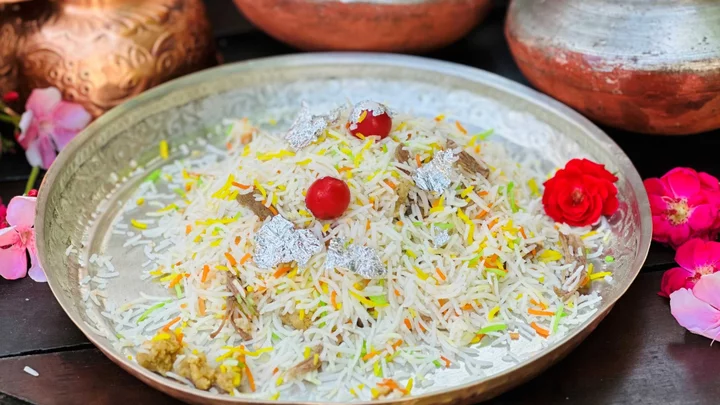
Mutanjan: The meat-and-rice dessert loved by Indian royals
For Muslims of the Indian subcontinent, mutanjan is a special dish, layered with memories and emotions.
2023-08-13 08:20

Mick Fleetwood says his Hawaii restaurant was ‘lost’ in devastating Maui wildfires
Mick Fleetwood has confirmed that his restaurant in Hawaii has been burnt down by the ongoing deadly wildfires in Maui. The Fleetwood Mac co-founder, 76, wrote in a post on X, the social media platform formerly known as Twitter, that Fleetwood’s on Front Street “has been lost” as the fires ripped through the historic town of Lahaina on the island. At least 67 people have died in the disaster, alongside more than 1,700 buildings and billions of dollars in property that have been destroyed. More than 14,000 people have been evacuated from Maui as of Wednesday. In his post, Fleetwood wrote: “Maui and the Lahaina community have been my home for several decades. This is a devastating moment for Maui, and many are suffering unimaginable loss. “Fleetwood’s on Front Street has been lost and while we are heartbroken, our main priority is the safety of our dear staff and team members. On behalf of myself and my family, I share my heartfelt thoughts and prayers for the people of Maui. “We are committed to supporting the community and those affected by this disaster in the days and months and years to come,” he added. Fleetwood opened his fine dining restaurant in 2012, featuring live entertainment and a rooftop area for customers to enjoy. The restaurant’s official Instagram account also shared a post, which read: “We do not have enough information at this time regarding Fleetwood’s on Front Street or any of our neighbours to share. Mahalo for your continued thoughts and prayers for our ohana, community and our first responders.” The wildfires began on Tuesday and have worsened throughout the week as a faraway hurricane fanned the flames, causing them to spread quickly. Governor Josh Green of Hawaii told a news conference on Thursday (10 August): “The full extent of the destruction of Lahaina will shock you. It does appear that a bomb went off.” US president Joe Biden issued a major disaster declaration and has ordered Federal aid to help local recovery efforts in the affected areas. He added in a White House statement: “Jill and I send our deepest condolences to the families of those who lost loved ones in the wildfires in Maui, and our prayers are with those who have seen their homes, businesses and communities destroyed. “We are grateful to the brave firefighters and first responders who continue to run toward danger, putting themselves in harm’s way to save lives.” A number of celebrities have also sent the people of Maui their well-wishes and have shared ways fans can help. Jason Momoa, who is Hawaiian, shared a post on Instagram to inform fans where they can donate to help with rescue efforts. He wrote: “We are devastated and heartbroken for our friends and ohana on Maui who [have] been impacted by the recent wildfires.” Bette Midler tweeted this week: “The beautiful island of Maui, in the most beautiful state in the union, is suffering. My family and I send our deepest and most profound sympathies to everyone who has lost anything or everything in the Maui fires.” Former US president Barack Obama has also spoken out and said in an Instagram Story: “It’s tough to see some of the images coming out of Hawaii – a place that’s special to so many of us. Michelle and I are thinking of everyone who has lost a loved one, or whose life has been turned upside down.” Read More Maui fires – live: Wildfires death toll climbs to 55 with 1,000 people still missing on Hawaii island ‘Heartbroken’ Aquaman star Jason Momoa reacts to ‘apocalyptic’ Maui wildfires Woman says her life was ‘blown up’ by viral plane rant where she called passenger ‘not real’ Where to find the best Guinness in London – and how to spot a bad one How to save money on your summer barbecue as prices soar Madeira: an unparalleled gastro heaven
2023-08-12 08:49
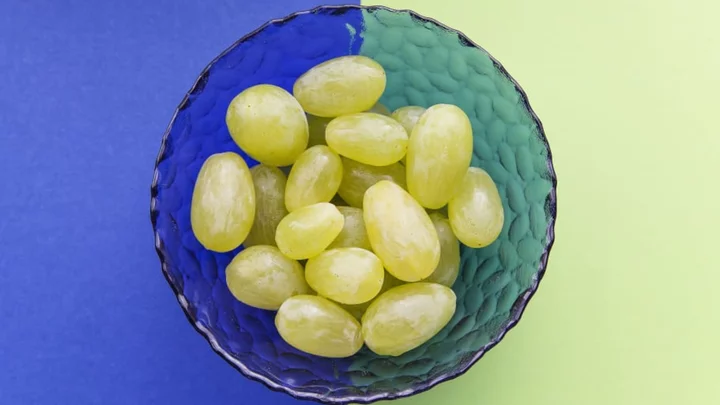
13 Fascinating Facts About Grapes
Wine grapes and table grapes are a huge agricultural asset. It's no wonder that the humble grape is among the world's largest fruit crops.
2023-08-12 06:18

Chicken Tenders vs. Chicken Fingers: What's the Difference?
All fried chicken tenders qualify as fingers, but not all chicken fingers are tenders.
2023-08-11 22:19
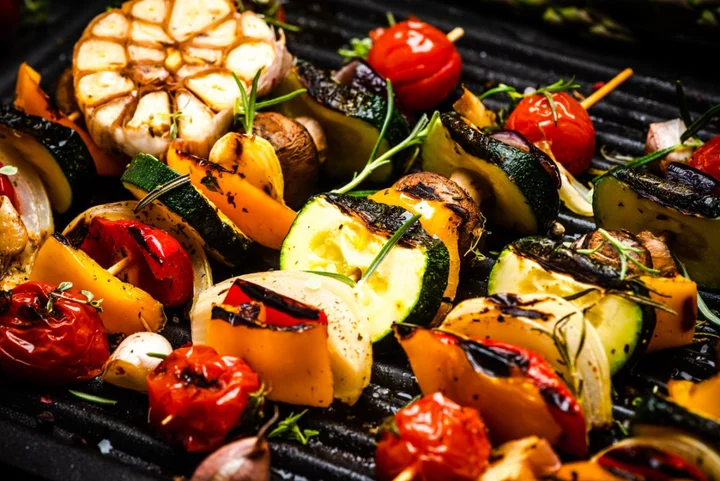
How to save money on your summer barbecue – as prices jump up from last year
Rising living costs are having a wide-ranging impact on our everyday lives, including when it comes to summer barbecues. In fact, the cost of food and drink for a typical summer barbecue in the UK could be around £10 more than last year, according to new calculations by Canada Life. The financial services provider, which used Office for National Statistics (ONS) figures to make the calculations, has put the cost of a typical barbecue at around £90, up from around £80 last summer. Of course, the actual cost will vary depending on exactly what you buy and how many people you’re catering for. In its basket of barbecue goods, Canada Life piled in products such as beef burgers, pork sausages, baking potatoes, chicken, meat-free sausages, veggie burgers, bread rolls, mayonnaise, cheese, salad ingredients, crisps, fizzy drink and alcoholic beverages. How can you keep barbecue costs down? If you’re keen to make the most of summer barbecue opportunities, but conscious of your budget too, Canada Life also has some tips. Spokesperson Shelley Greenwood suggests: “If you’re hosting more than once this summer, don’t throw out the charcoal after one use. Make sure you put out the fire safely and keep what is left in the barbecue for next time. Simply top up with new charcoal as needed.” Greenwood also suggests using price comparison apps such as Trolley to compare prices of items on your shopping list. “Then place your order through a cashback site to save even more,” she adds. She also suggests checking out apps for food in your local area that is being sold cheaply or perhaps even given away. For example, the Too Good to Go app allows people to search for bags of food being sold cheaply at places such as grocery stores, restaurants and cafes that might otherwise be destined to go to waste. Food sharing app Olio also helps stop surplus food going to waste, with users posting pictures of giveaways, including food and other items. Greenwood also suggests looking out for “yellow sticker” food items, which have been marked down in the supermarket, like cuts of meat or fish. Check these can be frozen and, if so, freeze them the same day and “simply defrost according to instructions ahead of your barbecue”, adds Greenwood. Also, rather than buying side dishes, go through your cupboards and fridge to see what ingredients could be transformed. Perhaps you could make your own pasta salad, or roast some tomatoes while you’re cooking something else, to create side dishes. You could also ask party guests to bring along a few sides to help share the costs. And if your priorities are more about having a summer gathering than firing up a barbecue, you could also consider by-passing the barbecue altogether and preparing food in your air fryer or slow cooker instead. Greenwood adds: “This way, you’re not reliant on the weather either.” Read More What I lost (and gained) by walking 10,000 steps each day for 5 months Woman says her life was ‘blown up’ by viral plane rant where she called passenger ‘not real’ How to save money in the kitchen according to top chefs Charity boss speaks out over ‘traumatic’ encounter with royal aide Ukraine war’s heaviest fight rages in east - follow live
2023-08-11 16:21

Midweek comfort food: Singaporean curry sauce and rice
There’s a meal in Singapore called ‘scissors-cut rice’, a selection of dishes piled high over a plate of lovely fluffy rice and topped with curry sauce,” says chef Jeremy Pang. “Originating from Hainanese Chinese descendants, the dish can be seen as a cross between a Malaysian nasi lemak and a Japanese katsu curry.” Curry sauce and rice Serves: 2 Ingredients: 2 cups of jasmine rice 2 cups of water 1 onion, finely diced ½ thumb-sized piece of ginger, peeled and finely chopped 2 garlic cloves, finely chopped 3 green chillies, pierced with the tip of your knife 1 potato, peeled and cut into 5cm chunks 300ml chicken stock 200g okra (swapsies: green beans), cut into 3-4cm lengths Vegetable oil For the sauce: 150ml coconut milk 1 tbsp sambal (swapsies: chilli bean sauce/toban jiang) 1 tbsp light soy sauce ½ tsp salt For the spices: 2 star anise 1 cinnamon stick 1½ tbsp curry powder Method: 1. Wash the rice at least three times. Place in a bowl and run under cold water, gently moving the rice grains between the tips of your fingers. Pour the rice through a sieve in between each wash, until the water runs clear. Sieve one last time and set aside. 2. Mix the sauce ingredients together in a jug. 3. Build your wok clock: start at 12 o’clock with the rice, followed by the onion, ginger and garlic, the spices, green chillies, potato, the sauce, chicken stock and lastly the okra. 4. Place the rice in a saucepan with the measured water. Cover with a tight-fitting lid, place on a medium-high heat and bring to a vigorous boil. Then reduce the heat to low and simmer with the lid on for 12-15 minutes until the liquid has evaporated to the point where you start to see air pockets form in between some of the rice grains. Replace the lid, turn the heat off and leave the rice to sit for another 15 minutes or so until ready to serve. 5. Once the rice is cooking, heat one to two tablespoons of vegetable oil in a saucepan to a medium heat, add the onion and fry for two to three minutes. Add the ginger and garlic and fry for a minute or so. Then add all the spices together, the green chillies and potato in turn, frying for about a minute after each addition. Pour in a quarter of the sauce and bring to a vigorous boil. Add another quarter of the sauce and again bring to a boil, then repeat this process until all the sauce has been added. Bring to a boil once again, pour in the chicken stock and cook on a medium heat for 20 minutes. Then add the okra and cook for five to 10 minutes before serving with the rice. ‘Jeremy Pang’s School Of Wok: Simple Family Feasts’ (Hamlyn, £22). Read More Marina O’Loughlin is wrong – there’s joy in solo dining Budget Bites: Three recipes to keep food bills down before pay day Meal plan: Romesco chicken and other recipes to fall in love with The chef who hated food as a child Who knew a simple flan could be so well-travelled? How to make Thai favourite lemongrass chicken stir-fry
2023-08-09 13:54
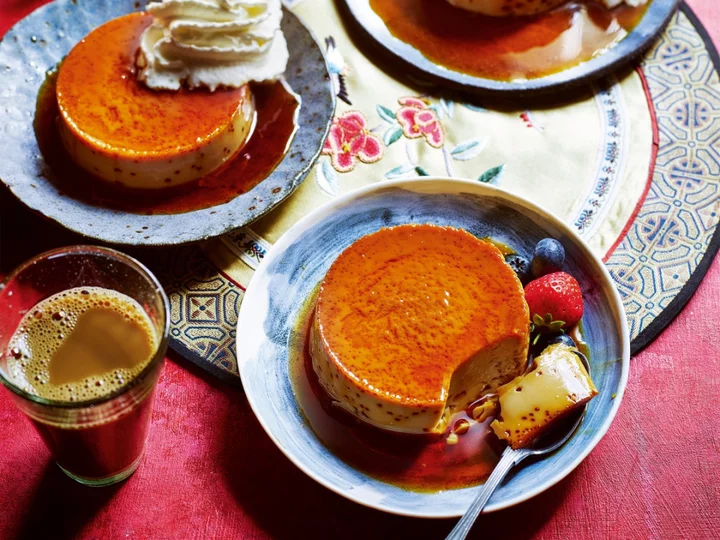
Who knew a simple flan could be so well-travelled?
Of all the sweet dishes in the world, you wouldn’t expect the simple flan to be so well-travelled,” says chef Jeremy Pang. “Yet when you look at the simplicity of its ingredients – essentially a sweetened and flavoured egg custard – you can see why so many cultures have adopted the flan into their own cuisines. “This coffee-flavoured version is found in most coffee shops in Vietnam, but it’s also one of the most popular desserts in the Philippines.” Coffee and coconut flan Makes: 10 Ingredients: For the caramel: 300g caster sugar 300ml water For the custard: 6 large eggs, at room temperature 400ml coconut milk 300ml condensed milk 1 shot of strong espresso (swapsies: 2 tbsp good-quality instant coffee dissolved in 1 tbsp hot water) Whipped cream, fresh fruit or sugared peanuts, to decorate Method: 1. Stand 10 ramekins in an ovenproof dish or a deep-sided baking tray. Preheat the oven to 160C/350F/gas mark 4. 2. For the caramel, place the sugar and water in a saucepan on a low heat and stir for three to four minutes, until the sugar fully dissolves. Increase the heat to high and allow the sugar syrup to boil vigorously, without stirring, for about five to six minutes until it reaches a rich golden brown colour, taking care to ensure it doesn’t burn. Once ready, carefully and without hesitation, divide the caramel between the ramekins to form a layer of caramel on the base of each one. 3. For the custard, crack the eggs into a large mixing bowl, add the coconut milk and condensed milk, and beat well to form a thick, smooth mixture. Add the coffee and stir in, then strain the custard through a fine mesh sieve into a jug. Divide evenly between the ramekins. 4. Pour boiling water into the ovenproof dish until level with the top of the custard in the ramekins, being careful not to get any in the flans. Bake for 45 minutes to one hour, depending on size, until set. Remove from the oven and allow to cool slightly, then remove the ramekins from the hot water, taking care not to burn yourself. Allow to cool completely before serving. 5. To serve, loosen the rim of each flan using a dampened finger and then turn out onto a serving plate. Decorate with whipped cream, fresh fruit or sugared peanuts. ‘Jeremy Pang’s School Of Wok: Simple Family Feasts’ (Hamlyn, £22). Read More Marina O’Loughlin is wrong – there’s joy in solo dining Budget Bites: Three recipes to keep food bills down before pay day Meal plan: Romesco chicken and other recipes to fall in love with The chef who hated food as a child Midweek comfort food: Singaporean curry sauce and rice How to make Thai favourite lemongrass chicken stir-fry
2023-08-09 13:54
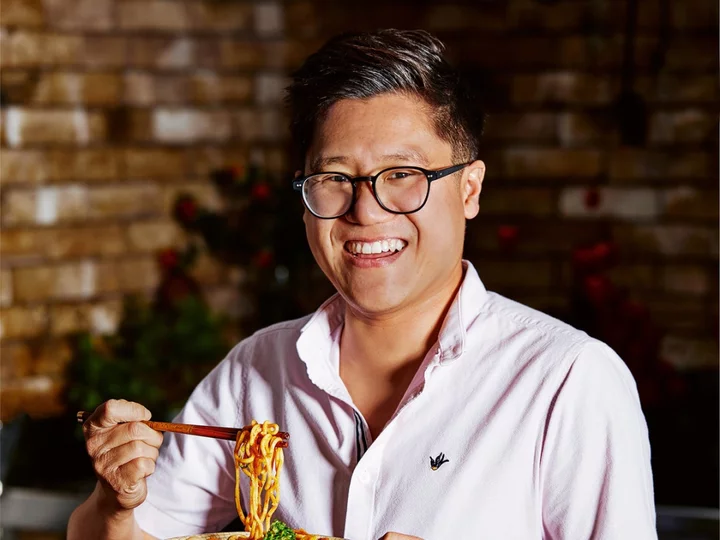
The chef who hated food as a child
Jeremy Pang doesn’t have a classic chef origin story: he “hated” food as a child. Before he turned 10, the chef, teacher and owner of the School of Wok in London admits: “I hated eating – I honestly did not like food. “Up to the age of, like, nine, it would take my mum two, three hours to get my dinner down me. I just didn’t want to eat – I wanted to go out and play football with my mates. I wanted to go and do stuff and play – I also wanted to eat fish fingers and all the stuff my friends were eating at home.” Pang grew up in a Chinese household and is a third-generation chef. When he was 10 years old, his family moved from the UK to Singapore for two years. Now aged 39 and based in southwest London, Pang says upon making the move, his “life completely changed”. He says: “When you go into hawker centres [open-air food markets] in Singapore, it’s a different world. Every single stall is a specialist in one type of food – not even cuisine. So you might have one uncle who has cooked chicken rice for his whole life, or another person who has cooked Hokkien Mee [a stir-fried noodle dish] for 40 years. “When people are as specialist as that, you cannot not want to eat it. And you see everyone digging into their food with no real etiquette – but the etiquette is the enjoyment of that bowl of food.” From there, Pang says Singapore “opened mine and my sister’s horizons” and he fell in love with food. With Singapore’s proximity to other Southeast Asian countries, he was exposed to a variety of cuisines – from Indonesian to Malaysian – many of which are taught at the School of Wok, along with the Chinese food Pang grew up with. With two kids of his own, aged six and two, Pang says: “I now feel so sorry for my mum.” Before the Covid-19 pandemic, the chef says of his oldest: “It was really difficult to get him to enjoy anything that wasn’t raw carrot or cucumber – which actually is healthy at least, but every day? That’s hard.” The pandemic shifted his son’s eating habits. Pang took a couple of months off and “cooked with him – we started making homemade pizzas, flapjacks – anything he wanted to make. He definitely at that point thought he had more of a Western palate, but I’ve known since he was really young and started eating that he does love Chinese food. “He likes the slightly lighter palate, and home-cooked Chinese food can be quite light – steamed fish, flash-fried vegetables, things like that.” One constant from Pang’s childhood to his family life now is the concept of feasting – serving multiple dishes for one meal. “This is how Asian cuisine is eaten, and should be eaten,” he says simply. “My style of cooking is 100 per cent home cooking anyway, and I’ve grown up with it. If you are Asian, that’s just a way of life. But if you’re not, it’s hard to compute how to get four or five dishes on the table, all hot or in the right state at the right time.” He continues: “Even if when we’re doing midweek meals at home, if I’m cooking Chinese or Southeast Asian just for the four of us, I’ll quite often cook two or three dishes. Those two or three dishes are there to be shared – that absolutely is our way of cooking and eating.” Pang’s latest book, Simple Family Feasts, is all about demystifying this concept for home cooks who haven’t grown up with it. Each chapter is dedicated to a different cuisine – including Chinese, Vietnamese, Singaporean and Indonesian – and shows you how to build a feast, guiding you through which dishes to make and in what order. Balance is crucial to pulling off a feast. “If, for example, you just ate crispy, deep-fried stuff – which is terribly bad for you, but we all love it – yes, you want to eat lots of it at the beginning. But five minutes later, you might get lost in that deep fried, crispy, greasy world, and so you’re likely to stop eating it at some point quite quickly. “But if you had something crispy, you have something opposite that melts in the mouth, you had something soft with a gentle bite, you had crunchy – usually from fresh vegetables or flash-fried vegetables, salads, anything like that – and you had a perfect balance of those textures. Honestly, I think you could just keep eating.” Growing up with this style of cooking must make Pang a brilliant multitasker – something he says is “a great skill to have”, but “sometimes it’s my worst enemy”. “I’m constantly multitasking – I get to the end of the day and I don’t know what’s happened, I sometimes can’t tell you what I’ve done in a day. I might have done a million different things… So in some ways, I’m very good at multitasking – but when I get home, my wife probably wouldn’t agree with that.” Like all of Pang’s cookbooks, this is an “ode to my father”, who passed away in 2009. “He’s the one who instilled that love of cooking and cuisine – especially Asian food. He never really taught me how to cook, he just said, ‘Stand and watch’, or, ‘Taste this and tell me what’s in it’. That was his style of teaching.” ‘Jeremy Pang’s School Of Wok: Simple Family Feasts’ (published by Hamlyn; £22). Read More Marina O’Loughlin is wrong – there’s joy in solo dining Budget Bites: Three recipes to keep food bills down before pay day Meal plan: Romesco chicken and other recipes to fall in love with Who knew a simple flan could be so well-travelled? Midweek comfort food: Singaporean curry sauce and rice How to make Thai favourite lemongrass chicken stir-fry
2023-08-09 13:48
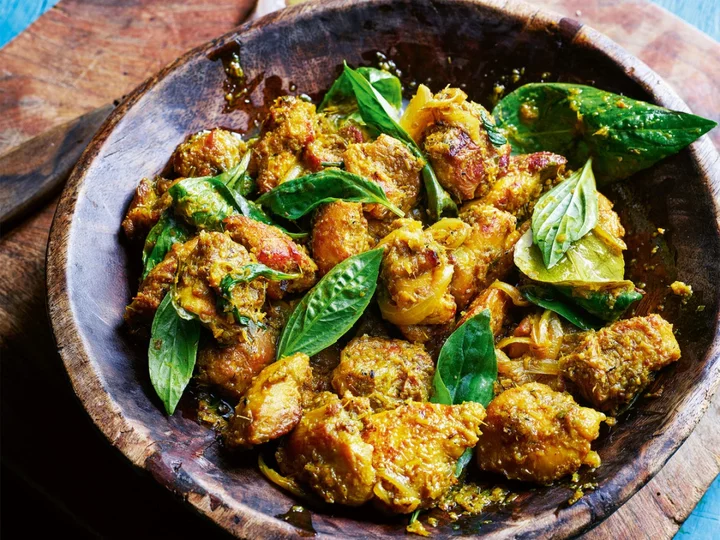
How to make Thai favourite lemongrass chicken stir-fry
I know with absolute certainty why this dish is a big-hitter on the School of Wok YouTube channel,” says chef Jeremy Pang. “Like many Thai curries and stews, it’s bold in flavour, but it can be cooked in a fraction of the time it takes for some of the slower-cooked recipes. “That means less time spent salivating over the stove and more time to eat. This fierce stir-fry will make your mouth water and your guests’ too – if you haven’t picked it all out of the wok before they arrive!” Lemongrass chicken Serves: 2 Ingredients: 4 skinless, boneless chicken thighs, cut into large chunks 1 tbsp chicken stock or water ½ white or brown onion, finely sliced 2-3 lime leaves Handful of Thai basil leaves Vegetable oil For the curry paste: 3 spring onions, finely chopped 3 garlic cloves, finely chopped 2 lemongrass stalks, trimmed, bruised and finely chopped ½ thumb-sized piece of ginger, peeled and finely chopped ½ thumb-sized piece of turmeric, peeledand finely chopped (swapsies: 1 tsp ground turmeric) 5-6 lime leaves, finely chopped ½ tsp salt For the sauce: 1 tbsp light soy sauce 1 tbsp fish sauce ½ tbsp palm sugar 50ml chicken stock Method: 1. Pound the paste ingredients together using a pestle and mortar, adding them one at a time, or blitz them in a food processor to form a smooth paste (you may need to add a tablespoon or so of water). 2. Mix the sauce ingredients together in a small bowl. 3. Place the chicken pieces in a bowl. Mix one tablespoon of the curry paste with the chicken stock or water and massage it into the chicken. 4. Build your wok clock: start at 12 o’clock with the marinated chicken, followed by the rest of the curry paste, the onion, the sauce, lime leaves and lastly the Thai basil leaves. 5. Heat one to two tablespoons of vegetable oil in a wok on a high heat until smoking hot. Add the marinated chicken and sear for a minute without moving, then fold the chicken over to sear on the other side for another minute or so. Once the chicken has a nice crisp edge and is fully browned, push it to the side of the wok. Add the curry paste to the centre of the wok, then the onion and fold the chicken over the mixture to incorporate and prevent the meat from burning. After about a minute, the onion should start to wilt. At this point, increase the heat and allow the wok to smoke before pouring the sauce around the edges of the wok. Bring to a vigorous boil, fold the chicken through and stir-fry for one to two minutes. Add the lime leaves and Thai basil leaves to finish and serve immediately. ‘Jeremy Pang’s School Of Wok: Simple Family Feasts’ (Hamlyn, £22). Read More Marina O’Loughlin is wrong – there’s joy in solo dining Budget Bites: Three recipes to keep food bills down before pay day Meal plan: Romesco chicken and other recipes to fall in love with The chef who hated food as a child Who knew a simple flan could be so well-travelled? Midweek comfort food: Singaporean curry sauce and rice
2023-08-09 13:45
